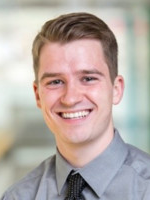Meet Kevin Rychel

Tell us a bit about your background: I’m originally from the suburbs of Chicago, and I completed my Bachelor’s in Biomedical Engineering (with a minor in Computer Science) at the University of Michigan. When I was there, I worked on a tissue-engineering treatment for diabetes. I loved that research because I was involved with all stages of designing and testing a system: nanoparticle and scaffold production, stem cell differentiation, animal studies, and imaging. I fell in love with quantitative problem-solving when I built an image analysis algorithm for our implant histology. I decided to attend grad school to build on these research skills and hopefully become a leading thinker in bioengineering. I was lucky enough to get accepted for the PhD program at UCSD, where I can work on world-class research with the added benefit of getting out of the biting cold of the Midwest.
What are you studying/researching? At UCSD, I switched gears to work solely on dry lab computational analysis -- it gives me time to really focus on whole system understanding of cells. I’m a member of Prof. Bernhard Palsson’s Systems Biology Research Group. When I joined, my mentor (Dr. Anand Sastry) had just developed a machine learning approach to study gene expression data in E. coli; it uses independent component analysis to generate sets of co-regulated genes called iModulons, which essentially tells us the main RNA signals that change within a cell and what they are doing under any condition. I expanded this work to show how it can be useful in another organism, B. subtilis. I also developed an online database for sharing the iModulons of every organism we’ve studied (iModulonDB.org), which microbiologists use to improve their understanding of their genes of interest. Now, I’ve begun integrating iModulon analysis with genomic data and in silico metabolic models in order to understand laboratory evolution studies. I hope to develop an integrated approach for a systems-level cellular understanding across DNA, RNA, and metabolites, that can inform the design of new genomes.
Tell us about your professional experience and campus involvement at UC San Diego: I have always loved teaching and mentoring, and my most fulfilling experience of that has been as a TA at UCSD. I TAed the undergraduate “Biomaterials” course, and then I TAed “Systems Biology: Analysis of Large Scale Biological Data” two years in a row. In both courses, I was able to lead student teams through course projects, which let me explore a wide range of interesting topics and deepen my leadership skills. I also helped with curriculum structuring, redesigned all homeworks, and got to build what felt like a close-knit community of students despite at-home learning in the pandemic.
I was also involved in the Rady School of Management’s technology management program, which gave me the opportunity to take a business course to perfect my startup pitching skills -- it was really interesting to see how different the business mindset is from the scientific one, and to communicate in such a way that I can bridge that gap.
My favorite activities to do in the San Diego area include: hiking and running our beautiful mountains, cliffs, and trails, laying out at the pool or beach with close friends, and waking up to yoga in the park. It’s important to cultivate a good work/life balance and enjoy the outdoors!
Why UC San Diego? Before my visit, I had already read about the astounding research we have here, particularly the computational biologists that lead the field on many fronts. The city is also one of the top three biotech hubs in the country, which is great for someone like me with a strong interest in industry jobs. At my visit, I was struck by how caring and fun all of the students and staff were -- a far cry from the uptight feeling a lot of academic settings have. When I first explored the city, I was amazed that there is something new and different in every neighborhood and around every corner (I have barely scratched the surface in three years of exploring). The weather, of course, is the best in the world. After all that, having a delicious burrito on the beach in February was just the cherry on top!